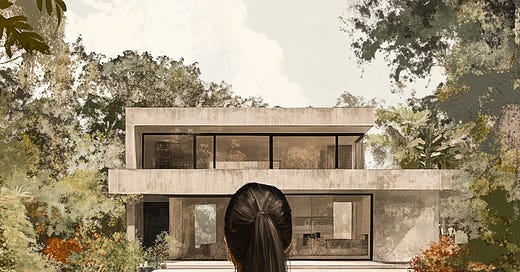I first learned about Building Biology during one of my deep dives into health podcasts. (Honestly, I can’t even remember which biohacker it was now—there have been so many! I’m a bit of a podcast addict) The term popped up, and I thought, ‘Wait, what is this?’
I was hooked.
At the time, I was knee-deep in trying to understand the connection between my environment and my health. My experience with mould had already opened my eyes to how much our homes can impact us, but this concept? It tied everything together.
What shocked me the most was that I’d been in the design and build industry for years, and I had never come across this. Learning about Building Biology was like finding the missing puzzle piece—it answered all the questions I’d been digging into about the impact of our environment on our health. It completely changed the way I view spaces, luxury, and even my role as a designer and builder forever.
(Learn more about my journey into healthy homes here.)
The Story of Building Biology
Building Biology, or Bau-Biologie, emerged in Germany in the 1960s as a response to widespread health concerns in post-war housing.
These homes, built quickly with synthetic materials and airtight designs, were making people sick. Doctors noticed unusual health issues—respiratory problems, fatigue—tied to indoor environments.
This phenomenon, later termed sick building syndrome, highlighted the unintended consequences of modern construction methods. Enter Dr. Hubert Palm, a German physician who coined the term Bau-Biologie. Dr. Anton Schneider took it further, developing the 25 Principles of Building Biology to address these challenges.
The movement sought to return to natural materials, improve ventilation, and integrate design practices that support human health. It also challenged the idea that progress had to come at the expense of well-being—a principle that resonates more than ever today.
Foundations of Building Biology
Building Biology is a holistic framework that blends multiple disciplines to create healthier living environments:
• Building Science: Understanding physical forces like moisture, heat, and air movement.
• Biology: Exploring how indoor spaces affect the human body.
• Ecology: Designing in harmony with natural systems.
• Health Sciences: Addressing chemical exposures, electromagnetic fields (EMFs), and other risks.
It treats homes as ecosystems, where every element—air, materials, energy—works together to support both occupants and the planet.
And what an ecosystem it is! Honestly, I’d never thought of my home as an ecosystem before, but now I can’t not! How we live is so deeply entwined with how we feel.
Want to understand why Building Biology is a game-changer in home design?
In my next post, I dive into how discovering Building Biology completely transformed the way I see luxury, wellness, and home design—and why it should matter to you too.






This article brilliantly captures the exciting paradigm shift happening in luxury! I love how you've articulated the evolution from material status symbols to meaningful well-being experiences. The way you connect positive psychology research with luxury markets is incredibly insightful. Your examples of brands embracing this transformation are spot-on and inspiring. As someone passionate about both wellness and thoughtful consumption, I find your perspective refreshing and forward-thinking. The concept of 'invisible luxury' resonates deeply - that true luxury is increasingly about how experiences make us feel rather than what we can show others. Thank you for this thought-provoking piece that helps us reimagine what luxury can and should be in our lives!